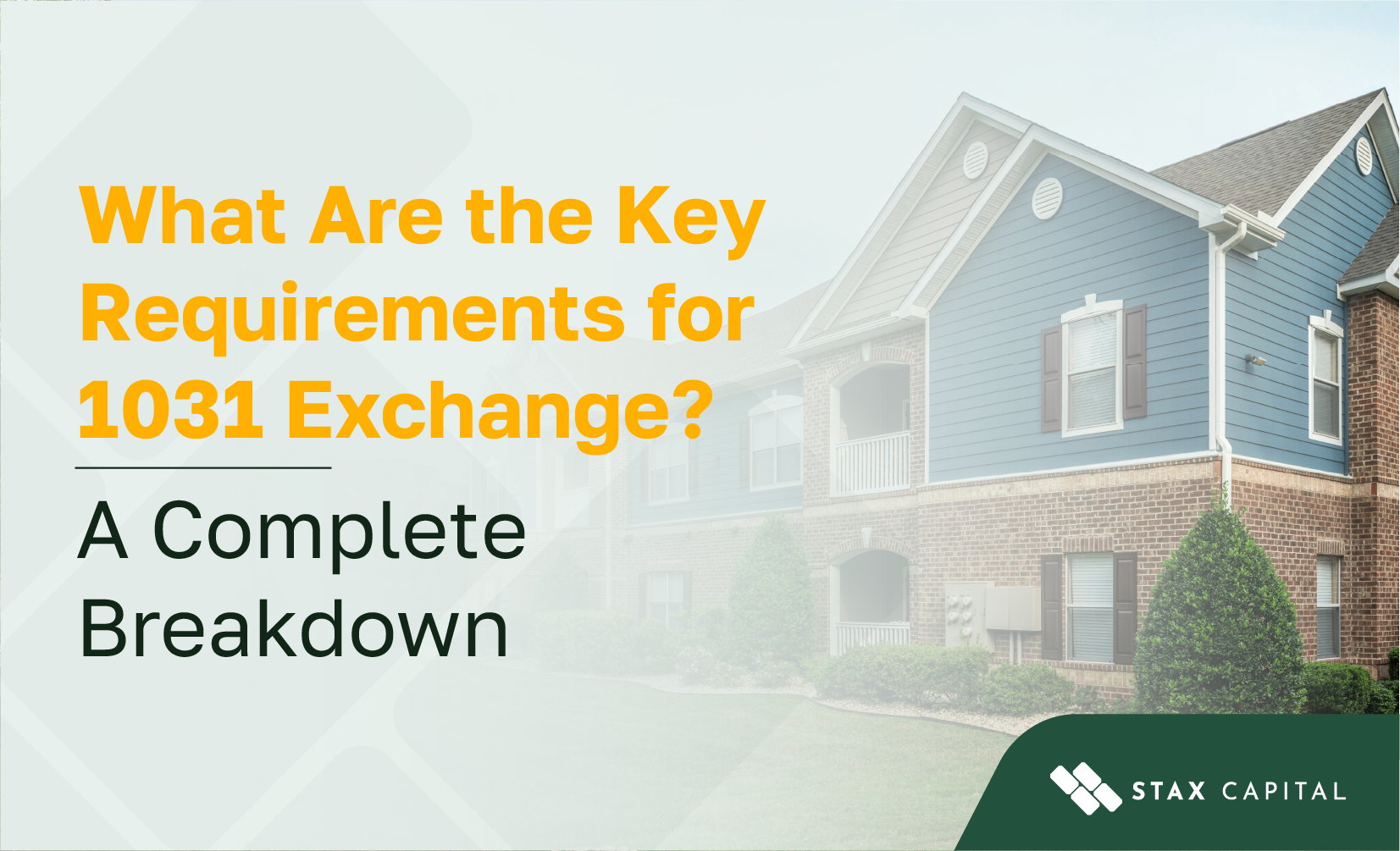How to Simplify the 1031 Exchange Process

Exchange Tips
If you’re thinking about reinvesting in real estate, a 1031 exchange can be a fantastic way to defer capital gains taxes while growing your portfolio. But with its strict rules and timelines, the process can be intimidating.
Don’t worry—we’ve got you covered! This article breaks down the basics of a 1031 exchange, offering tips on how to simplify a 1031 exchange and make informed decisions to ensure a smooth exchange from start to finish.
What is a 1031 Exchange?
A 1031 exchange is a tax strategy that allows real estate investors to defer capital gains taxes when they sell an investment property and reinvest the proceeds into a similar, or “like-kind,” property. This approach lets investors expand their portfolios without immediate tax obligations, reaping potential 1031 exchange tax benefits. However, investors should be aware of potential risks and strict compliance requirements.
While the rules for qualifying as a 1031 exchange are strict, such as choosing like-kind properties and meeting specific 1031 exchange deadlines and timelines, the long-term potential benefits can be significant.
For example, suppose you own a single-family rental home that you sell for $400,000. Instead of paying taxes on the sale, you can use those funds to buy a multi-family unit. This way, you can grow your investment portfolio while avoiding a hefty tax bill.
Step-by-Step Guide to Simplifying the Process
Navigating the 1031 exchange process can seem daunting, but breaking it down into manageable 1031 exchange steps makes it easier. This section will walk you through each stage, ensuring you know what to expect and how to prepare.
Engage in a 1031 Exchange
Before diving into a 1031 exchange, consider whether it aligns with your investment goals. Assess your current portfolio and future objectives. Are you looking to defer taxes? Are you ready to transition to a different type of property? Understanding your financial aspirations will help you determine if a 1031 exchange is the right move for you.
Seek Professional Guidance
Consulting a qualified intermediary (QI) or tax advisor is crucial to ensure compliance and minimize risks. These professionals have in-depth knowledge of the 1031 exchange process. They can guide you through the complexities, ensuring compliance with IRS regulations. Their expertise can help you avoid costly mistakes, making the process smoother and more efficient.
Choose a Qualified Intermediary
Finding a reputable QI is critical to your success. Look for someone with experience in 1031 exchanges and a solid reputation. Check reviews and ask for referrals. A good QI will facilitate the transaction, manage necessary paperwork, and help you meet critical 1031 exchange deadlines and timelines. Their role is essential in ensuring a successful exchange.
Sell the Relinquished Property
Once you have your QI in place, it’s time to market and sell your current property. Utilize online listings, social media, and real estate agents to reach potential buyers. Highlight the property’s best features and make necessary improvements to attract interest. A swift sale is key to starting your 1031 exchange process.
Identify Replacement Properties
After selling your property, focus on identifying replacement properties. You have a 45-day window to list potential properties. Consider factors like location, property type, and potential return on investment. Be mindful that economic fluctuations and local market conditions can impact property value and returns.
Be strategic in your selections, ensuring they align with your investment goals. Keep your QI informed of your choices to stay within 1031 exchange deadlines and timelines.
Close on the Replacement Property
The final step is closing on your new property. You have 180 days from the sale of your original property to complete this transaction. Work closely with your QI to finalize all necessary paperwork and ensure compliance. This is a crucial time, so stay organized and adhere to all deadlines to successfully complete your 1031 exchange.
It’s important to note that 1031 exchanges come with liquidity limitations and strict compliance rules. Investors should be prepared for the potential of illiquid holdings during the exchange process.
Avoiding Common Pitfalls
While the 1031 exchange offers potential benefits, it also comes with potential pitfalls. Awareness of these common mistakes can save you time, money, and stress. In this section, we’ll highlight the most frequent errors investors make during the 1031 exchange steps and provide tips on how to sidestep them, ensuring a smoother exchange experience.
Missing Deadlines
One of the most common mistakes investors make is overlooking crucial deadlines in the 1031 exchange process. The 1031 exchange has strict time frames. You have 45 days to identify replacement properties and 180 days to close on them. Missing these deadlines can disqualify your exchange and result in significant tax liabilities.
Tips to avoid this pitfall:
- Create a Timeline: Draft a clear timeline that outlines key dates for your exchange and keeps each of the 1031 exchange steps organized.
- Set Reminders: Use calendar alerts or project management tools to remind you of upcoming deadlines throughout the 1031 exchange process
- Regular Check-ins: Review your progress regularly to ensure you're on track.
Failing to Properly Identify Replacement Properties
Another frequent error is not clearly identifying replacement properties within the 45-day window. The IRS requires specific details about each property, including address and type. Failing to provide this information can jeopardize your exchange.
Tips to avoid this pitfall:
- Work with a Qualified Intermediary (QI): Your QI can guide you through the identification rules and ensure you meet all requirements of the 1031 exchange process.
- Be Specific: When identifying properties, include complete addresses and any necessary details.
- Keep Options Open: Identify more properties than you plan to purchase to maintain flexibility.
Mixing Personal-Use and Investment Properties
A major mistake is confusing personal-use properties with investment properties. The IRS has clear guidelines about what qualifies as an investment property in a 1031 exchange. If you attempt to include properties that are primarily for personal use, you risk disqualification in the 1031 exchange process.
To avoid this, make sure all properties you plan to exchange are strictly for investment purposes. Consulting with a tax advisor can help clarify which properties qualify.
Tips to avoid this pitfall:
- Consult a Tax Advisor: They can help clarify which properties qualify for the exchange.
- Understand IRS Guidelines: Familiarize yourself with the IRS definitions of personal and investment properties before starting the 1031 exchange process.
- Strictly Define Your Portfolio: Ensure all properties you plan to exchange are used solely for investment purposes.
Key Timelines and Deadlines
In a 1031 exchange, strict 1031 exchange deadlines and timelines are essential. You have 45 days from the sale of your relinquished property to identify potential replacement properties. This means you must create a list of properties you are considering to acquire. Each property must meet IRS guidelines, so clarity is vital.
After identifying your properties, the clock continues. You have an additional 135 days to complete the purchase of at least one of those identified properties. This 1031 exchange deadline is non-negotiable. Failing to meet either timeframe can result in disqualification of the exchange, triggering significant tax liabilities and penalties.
To stay organized, consider these helpful strategies:
- Create a Detailed Schedule: Make a detailed timeline that highlights each important date within the 1031 exchange deadlines. Clearly mark the start and end of both the 45-day and 180-day periods.
- Set Digital Reminders: Use calendar apps or task management apps to set alerts for each milestone. This will keep deadlines top-of-mind and help prevent last-minute rushes.
- Conduct Weekly Check-ins: Review your progress regularly. This allows you to make any necessary adjustments to your plans without feeling rushed as the deadlines approach.
- Engage Your Qualified Intermediary (QI): Your QI is a valuable resource. They can provide reminders of key dates and offer guidance to ensure compliance throughout the process.
How to Choose Like-Kind Properties
Choosing the right like-kind properties is crucial in a 1031 exchange. Here are some detailed guidelines to help you make informed decisions:
Clearly Define Your Investment Objectives
Start by identifying your investment goals. Consider what type of property you want—residential, commercial, or industrial. Think about the location and how it aligns with your long-term growth and cash flow expectations. Having clear objectives will guide your property search.
Work with Experienced Real Estate Professionals
Engage with real estate agents or brokers who specialize in the properties you are interested in. Their expertise can provide valuable insights into market trends and property values. They can also help you navigate the complexities of the 1031 exchange.
Conduct Thorough Market Research
Dive deep into the local real estate market. Analyze property values, rental rates, and vacancy rates. Understanding economic trends will give you a clearer picture of which properties are likely to appreciate over time. This research is vital for making sound investment choices.
Ensure that any chosen property meets IRS requirements for like-kind exchanges. Consulting a qualified tax or real estate advisor can help confirm compliance.
Attend Real Estate Investor Meetings and Conferences
Networking can be a game-changer. Attend local real estate meetings and conferences. Connect with other investors and professionals. These interactions can reveal new opportunities and keep you informed about market dynamics.
Leverage Technology
Use online platforms and real estate listing websites to streamline your property search. Many of these tools offer customizable filters, allowing you to narrow down options based on your specific criteria. Just remember, the 45-day identification period for a 1031 exchange is strict. Conduct thorough research to ensure you identify suitable replacement properties on time.
Ready to start your 1031 exchange journey?
Navigating the 1031 exchange can be complex, but with the right knowledge and support, it becomes manageable. Remember to set clear goals and work with qualified professionals.
For personalized assistance, reach out to us at Stax. We're here to help you simplify your investment journey.



Share: